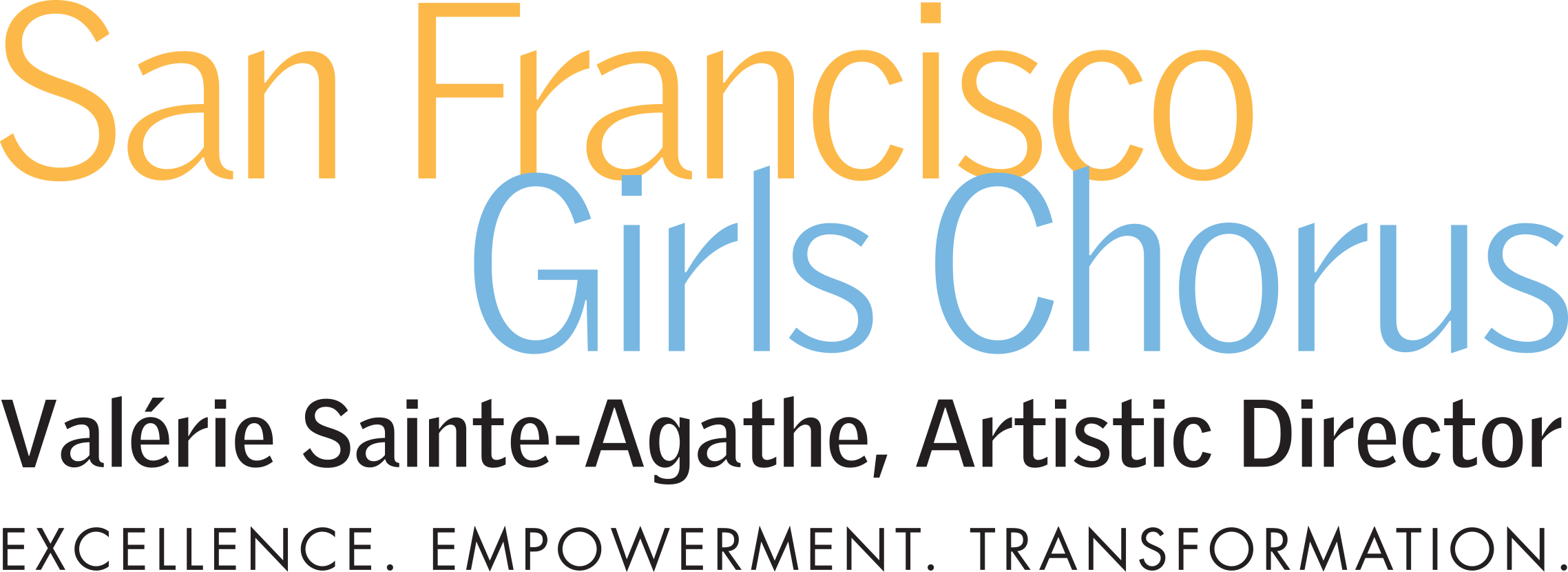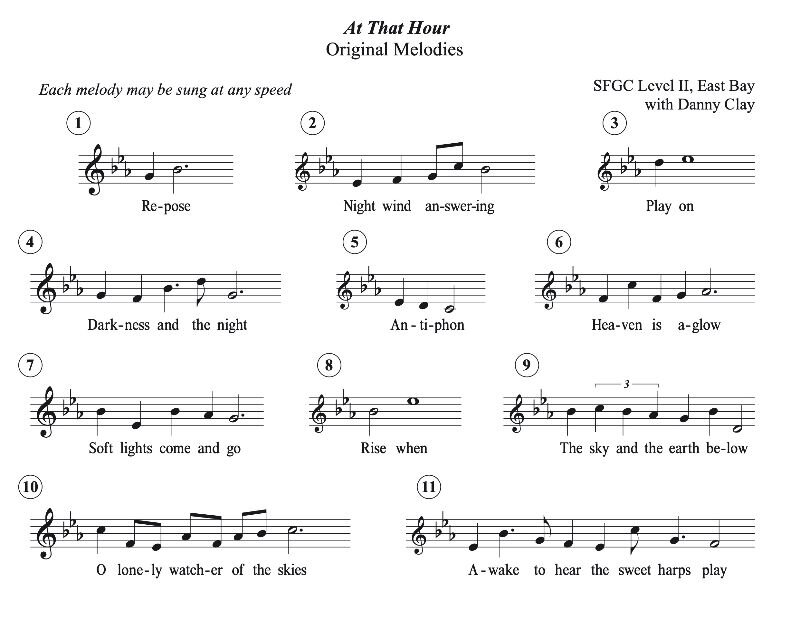Postcard card from Danny Clay and MaryStarr Hope
This week’s postcard comes from composer Danny Clay and improviser, dance artist and aerial dancer MaryStarr Hope. Danny Clay served as SFGC's 2018-2019 Chorus School composer-in-residence and recently recomposed an existing work, At That Hour, for our Level II choristers to be performed this spring. MaryStarr Hope joins our Level IV choristers as a performance coach for projects entitled At That Hour and Radio Play.
Danny Clay, composer
When along your musical journey did you decide you wanted to be a composer?
As a baby, I took my first steps while blowing on a harmonica, so I guess the seed was planted early! I had an odd obsession with pipe organs as a kid after seeing one at a cousin’s wedding, and wrote a little ditty in D minor for pipe organ when I was in elementary school that has yet to be played. My father taught me to play the drum set and guitar in middle school, too, and I played in a number of bands. I was always a little bit bossy as a band member – asking people to play certain things at certain times, kind of guiding the shape of the song along in different ways. By high school all of these experiences kind of snowballed into an ongoing interest in collecting sound, and the art of learning about sound and putting sounds together. I realized that I’d be totally happy doing this kind of thing for the rest of my life.
What values do you see composition having as a young musician?
If approached a certain way, I think composing offers the same sense of creative possibility that drawing or writing does for a young person. Composing is about building your own musical universe in sound that is totally on your own terms. You can pull ideas and inspiration in from the world around you, or invent new ones – the whole world of sound is yours to collect, organize, tinker with, discover, invent, re-invent. You can use these tools to express things that you’re feeling, or discover entirely new feelings – things, perhaps, that you might not want to share - or be able to share - with words alone. An unconditional personal resource for communication, self-growth, self-care, and making sense of the world around you and your place in it – that’s what I think composing has to offer.
A lot of folks seem to think that one should learn theory and musicianship before one can begin composing, but this seems totally backwards to me. If we explore music hands-on and discover with our own brains and bodies the ways that it makes sense to ourselves, the musical building blocks as they are normally taught become a lot more intuitive and potentially useful.
Danny Clay leads a composition session as part of our Summer Chorus Camps for Young Singers in 2018
How do you find your inspiration for bringing creativity and imagination into your work with composing with young singers, and how did this lead you to re-compose At That Hour with Level II?
99% of the creativity in the work I do comes from my collaborators! Instead of offering a specific vision for how a work will look and sound, these days I try to approach projects with an open-ended inquiry for me and my collaborators to answer together. Nothing makes me happier than to hear what ideas young people have for new music, so I like to offer friendly questions and challenges that I hope will inspire them to discover ideas. From there, my role is not so much to create, but to facilitate by offering observations, identifying patterns or connections, and helping guide that process along for my collaborators as best as I can.
In the case of this project, I knew Level II was going to be performing a song I wrote called “At That Hour” in the spring of this season. Since composing is just the act of noticing, collecting, and organizing sounds, I wondered what would happen if they were to listen to the piece and make it their own by simply keeping track of words and melodies that they found interesting or meaningful and putting together in a new way. So as a group, we made a little ‘inventory’ of melodies and words from the song that they noticed, changed some details that we thought might sound even better, and decided what order we wanted those ideas to happen in. Voila! We arrived at two new pieces that, I think, are even cooler than the original, since they include ideas that I would have never dreamed of on my own.
What inspiration do you take into your career after working with SFGC?
I’ve been thinking a lot lately about the beauty and meaningfulness that comes from approaching a project with a “we” mindset instead of a “me” mindset. SFGC, for me, embodies that community mindset in every facet of their organization, and that makes y’all such a perpetual delight and inspiration to work with over and over again. Every time I work with the SFGC Chorus School, I’m struck by their enthusiasm, passion, curiosity, imagination, and – most importantly – the sheer joy they find in making music, even now when we’re all separated by screens. After an SFGC project, I’m always more empowered than ever to be the best musician and collaborator that I can be, because I know that these young musicians ARE doing those things. Our responsibility as grown-up artists is not to impart wisdom to youth - it is to recognize their creativity and passion, to hear them, learn from them, be inspired by them – to uplift and amplify their voices in the way they deserve to be heard. It’s a responsibility – and a privilege!
Original version of Danny Clay's At That Hour for soprano and piano (performed by Emma Rosenthal and Tim Bach, April 2014)
Why is it important to continue practicing music and have online performances in this time of pandemic?
The reasons to have musical performance and creation in one’s life during these unprecedented times are probably different for everyone. Whether it’s for comfort, distraction, healing, reflection, meditation, or connection of some kind – I’d be hard pressed to say one reason is any more important – or more meaningful – than another!
MaryStarr Hope, dance artist
MaryStarr Hope and Karla Quintero performing the award-winning duet, The Two Sisters, from Grace and Delia Are Gone (Fort Mason in 2016) Credit Austin Forbord.
When along your artistic journey did you decide you wanted to be a dancer/choreographer?
I grew up performing in musical theater, my hometown in New Hampshire had a wonderful community theater company. We staged Broadway musicals and Gilbert and Sullivan operettas every year. I actually sang in chorus myself, as my mom is a singer, and I grew up with voice lessons being taught in my living room. I started to train as a dancer when the first dance studio opened in my area, at age 11. I decided to dance professionally at age 14. It felt like a realization, rather than a choice. A discovery and acceptance that a dancer is simply who I AM. Not a job, so much as an identity.
How do you find your inspiration for bringing creativity and imagination into your work with composing with young performers?
When I work with any performers, young or grown, I take my inspiration from them. Seeing them move. Experimenting together. In the company I dance with, the dancers generate our own movement material and our director manipulates it. It’s a necessity, in an aerial dance company, as often she doesn’t know what’s physically possible for us in a given space or with a particular set as individual movers. So we have to experiment and she builds the piece out of what we create to show her. In my directorial role I find that I like to make movement live when I’m working with performers, just being in their company inspires me. That is tricky in this moment, over the zoom stage, because we aren’t really together ever. But I’m a big believer in new ideas and adventure so it’s been fun to explore a new frontier.
Can you describe the work you are doing with the San Francisco Girls Chorus Level IV?
I am working with Level IV in two capacities - specifically to stage movement for their project creating a Radio Play, and more generally as a performance coach to help them develop a fully embodied stage presence as singers. We are using this project as a lab for practicing the essential elements of every successful performance - commitment, clear choices, and holding your space on stage. I’ve done some fun experimenting with Level IV about how to use the zoom frame and teaching them about improvising movement, and given them movement scores to improvise within. It’s not practical to perform unison movement over zoom, so we’ve talked a lot about the post-modern dance and music period because I think it’s most relevant to what we are doing. The post modernists (The Judson Church) really shook up the idea of choreography and developed the idea of improvisational scores for movement.
Can you tell us more about Radio Play?
Radio Play is a very cool project! The ensemble has crafted a story that incorporates their fall repertoire and written a series of episodes to tell that story. They have created characters, roles and dialogue. The girls in Level IV are involved in all aspects of this piece - conception to performance. I think Level IV is so lucky to have a director who is an accomplished composer. Anne is really using this moment to give them a new opportunity to explore what it means to be a creative artist rather than an interpretive artist. It’s pretty special.
MaryStarr Hope features in the 2019 dance film The Wait
What inspiration do you take into your career after working with SFGC?
I am so inspired by the bravery and commitment of Level IV! It takes a lot of confidence to present your own work to a live audience, rather than to interpret the work of a master composer. I’ve been renewed in my own feelings of commitment to the practice of making new art. And during this time, when so many artists are without a stage, it has been a great comfort to me, and a great honor, to be in rehearsals with these young performers. They are magic!
Why is it important to continue practicing music and have online performances in this time of pandemic?
We practice because that is who we are. This is a moment that reminds us that ultimately, we make the work because it simply has to be done. The music must be made. The dancing must be done. Art is an imperative for those it dwells within. It must be expressed. At this point in the development of young artists, they must continue to grow and push and challenge themselves, always. Exploring new ways to bring your work to your audience is a great opportunity!




